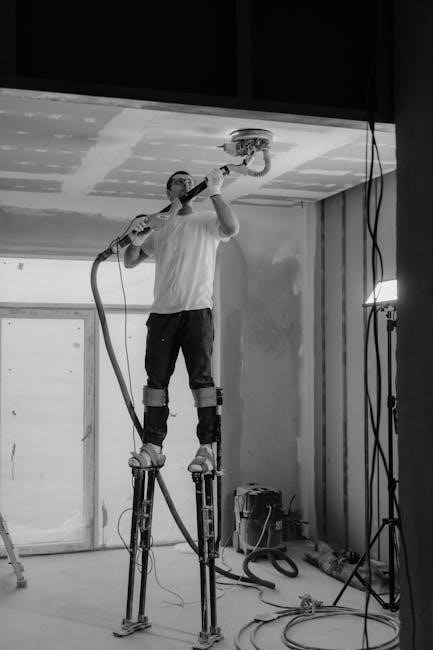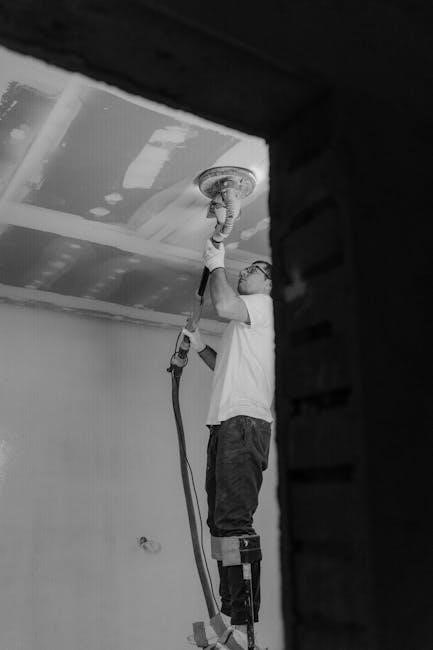Hunter ceiling fan manuals provide essential guidance for installation, operation, and maintenance. Available as PDF downloads on platforms like ManualsLib, Hunter Fan Support, and Internet Archive, these resources ensure optimal performance and safety.
1.1 Importance of Reading the Manual
Reading the Hunter ceiling fan manual is crucial for safe installation, operation, and maintenance. It provides detailed instructions for assembling and mounting the fan correctly, ensuring optimal performance and preventing hazards. The manual outlines safety precautions, such as turning off power before installation, and highlights essential tools and materials needed. Additionally, it explains how to operate the fan’s features, adjust settings, and troubleshoot common issues. Understanding the manual helps users maximize energy efficiency and extend the fan’s lifespan. Neglecting to read it may lead to improper installation, reduced functionality, or even safety risks. Always refer to the manual for specific guidance tailored to your fan model.
1.2 Overview of Hunter Ceiling Fan Models
Hunter ceiling fans are available in various models, each designed for different aesthetics and functionalities. The manuals provide detailed specifications for models like the Architect series, ensuring users understand their unique features. From traditional to modern designs, Hunter offers fans with advanced technologies like remote controls and smart home integration. The manuals categorize these models, making it easier for users to find information specific to their fan. Whether it’s energy efficiency, blade designs, or control options, the manuals cover all aspects. This ensures that users can make informed decisions and maintain their fans effectively, optimizing performance and longevity. The comprehensive guides reflect Hunter’s commitment to quality and user satisfaction.

Installation Guidelines
Hunter ceiling fan manuals provide detailed installation instructions, ensuring safe and proper setup. They include step-by-step processes, safety precautions, and tools required for a successful installation.
2.1 Step-by-Step Installation Process
The Hunter ceiling fan manual provides a detailed, step-by-step installation guide. Begin by preparing the installation site, ensuring the power is off and the area is clear. Next, unpack and organize all components. Mount the ceiling bracket securely, following the manual’s instructions. Proceed to install the fan motor, ensuring proper alignment and tightening of screws. Connect the wiring carefully, referring to the color-coded diagram in the manual. Finally, assemble the fan blades and attach any additional accessories like light kits or remote controls. Double-check all connections for safety and test the fan at a low speed before full operation. Proper installation ensures optimal performance and longevity of the fan. Always follow the manual’s specific instructions for your model.
2.2 Safety Precautions During Installation
Before installing your Hunter ceiling fan, ensure the power supply is turned off at the electrical panel. Verify this using a voltage tester. Always follow the manual’s safety guidelines to avoid accidents. Wear protective gear, such as gloves and safety glasses, when handling tools and components. Ensure the installation area is clear of debris and obstacles. Avoid wearing loose clothing or jewelry that could get caught in tools or moving parts. Never stand on an unstable surface; use a sturdy ladder or step stool. If unsure about any step, consult a licensed electrician. Keep children and pets away from the work area. Follow all local electrical codes and manufacturer instructions to ensure a safe and proper installation.

2.3 Tools and Materials Required
For a successful Hunter ceiling fan installation, gather the necessary tools and materials beforehand. A voltage tester, screwdrivers (Phillips and flathead), pliers, and a wrench are essential. A sturdy ladder or step stool is needed for safe access. Ensure you have wire strippers, wire nuts, and a drill with bits for mounting. The fan typically includes mounting hardware, but verify the contents. Additional materials like screws, washers, and a ceiling medallion may be required. Refer to the specific model’s manual for any unique tools or parts. Organizing these items beforehand ensures a smooth and efficient installation process.

Understanding Fan Components
Understanding fan components involves identifying key parts like blades, motor, and mounting hardware. The model number, found in manuals, helps in recognizing specific components and their functions.
3.1 Identifying Key Parts of the Ceiling Fan
Identifying key parts of a Hunter ceiling fan is crucial for proper installation and maintenance. The fan typically includes components such as the motor housing, blades, mounting bracket, and control systems. The motor housing contains the internal mechanisms that power the fan, while the blades are designed for air circulation. The mounting bracket secures the fan to the ceiling, ensuring stability. Control systems, like pull chains or remotes, regulate speed and direction. Referencing the manual helps in accurately identifying each part, ensuring you understand their functions and how they contribute to the fan’s overall operation and efficiency.

3.2 Locating the Model Number
Locating the model number on your Hunter ceiling fan is essential for accessing the correct manual and ensuring compatibility with accessories. According to Hunter Fan Support, the model number is typically a 5-digit code, sometimes followed by a letter (e.g., 22345A). This number is usually found in the installation manual or on the packaging. For fans without packaging, check the motor housing or the base of the fan. The model number is crucial for identifying the specific features and requirements of your ceiling fan, ensuring accurate troubleshooting and maintenance. Referencing the manual or Hunter’s support site can also guide you in locating this information effectively.
3.3 Types of Controls and Accessories
Hunter ceiling fans offer a variety of controls and accessories to enhance functionality. These include wall switches, remote controls, and pull chains, allowing users to adjust speed and direction. Accessories like light kits, blades, and mounting hardware are also available. The manual provides details on compatible accessories for each model, ensuring optimal performance. Users can find specific information about controls and accessories in the Hunter ceiling fan manual PDF, which outlines installation and operation guidelines. These resources help users customize their fan to meet specific needs, improving both aesthetics and functionality. Always refer to the manual for compatibility and installation instructions to ensure safety and efficiency.

Operating the Ceiling Fan
Operating a Hunter ceiling fan is straightforward, with options like remote controls, wall switches, or pull chains for easy speed adjustments. The manual provides detailed guidance for smooth operation.
4.1 Basic Operation and Functionality
Mastering the basic operation of your Hunter ceiling fan ensures optimal performance and energy efficiency. Begin by familiarizing yourself with the fan’s primary functions, such as turning it on/off and adjusting speed settings. Most models come with a pull chain or wall control, while others may include remote control functionality. The fan typically features multiple speed settings to customize airflow according to your needs. For energy-saving benefits, use the reverse function during winter to circulate warm air. Always refer to the manual for specific instructions tailored to your model, as functionality may vary. Proper operation not only enhances comfort but also prolongs the fan’s lifespan. Regularly review the manual to ensure you’re utilizing all features effectively.
4.2 Adjusting Speed Settings
Adjusting the speed settings on your Hunter ceiling fan is straightforward, allowing you to customize airflow to suit your preferences. Most models feature a pull chain or wall control with multiple speed options, typically ranging from low to high. For added convenience, some fans come with remote controls, enabling easy adjustments from a distance. The manual will outline the specific steps for your model, but generally, pulling the chain or pressing a button cycles through the settings. Additionally, some models include a reverse function, which can be activated to change the fan’s rotation direction for seasonal energy efficiency. Proper use of speed settings ensures optimal air circulation and energy savings, enhancing overall comfort in your space.
4.3 Troubleshooting Common Issues
Troubleshooting your Hunter ceiling fan begins with consulting the manual for model-specific guidance. Common issues include imbalance, noise, or lights not working. Check the Hunter Fan support site for solutions. For blade wobbling, ensure screws are tightened and blades are balanced. If the fan is noisy, verify proper installation and blade alignment. For light issues, confirm bulbs are securely fitted and switches are functioning. Refer to the manual’s troubleshooting section for detailed fixes. Regular maintenance, like cleaning and tightening parts, prevents many problems. If issues persist, contact Hunter Fan support for assistance. Always follow safety precautions when troubleshooting to avoid accidents or further damage.

Maintenance and Care
Regularly cleaning the fan blades and checking for loose screws ensures smooth operation. Balancing the blades prevents wobbling, and replacing worn parts maintains efficiency. Refer to the manual for detailed care instructions.

5.1 Cleaning the Ceiling Fan
Cleaning your Hunter ceiling fan regularly ensures optimal airflow and aesthetics. Turn off the power at the switch and circuit breaker for safety. Use a soft, dry cloth to wipe down the motor housing and blades. For stubborn dust, dampen the cloth slightly but avoid harsh chemicals or abrasive cleaners, as they may damage the finish. Remove any light kits or glass covers and clean them separately with mild soap and water. Regular cleaning prevents dust buildup, which can reduce efficiency and create noise. Always refer to your Hunter ceiling fan manual for specific cleaning instructions tailored to your model. Proper maintenance ensures your fan runs smoothly and lasts longer. Cleaning is a simple yet crucial part of overall fan care.
5.2 Balancing the Fan Blades
Balancing your Hunter ceiling fan blades is crucial for smooth operation and to prevent wobbling. Start by turning off the power and ensuring the fan is still. Use a balancing kit, typically included with your Hunter fan, which contains weights and clips. Attach the balancing clip to each blade, beginning with the heaviest one, and adjust the weights until the fan runs evenly. If the fan still wobbles, check for loose screws or uneven blade alignment. Proper balancing ensures quiet operation and reduces strain on the motor; Always follow the specific instructions in your Hunter ceiling fan manual for the best results. Regular balancing helps maintain efficiency and extends the fan’s lifespan.
5.3 Replacing Parts and Accessories

Replacing parts and accessories for your Hunter ceiling fan is straightforward when following the manual. Identify the specific part needing replacement, such as light kits or blades, using the model number found in the manual. Purchase genuine Hunter parts for compatibility. Turn off the power and let the fan cool before starting. Use a screwdriver to remove the grille or glass cover to access internal components. Replace the faulty part with the new one, ensuring all connections are secure. Reassemble the fan in the reverse order of disassembly. Test the fan to ensure proper function. Regularly replacing worn parts enhances performance and safety. Always refer to your Hunter ceiling fan manual for detailed instructions and diagrams. This ensures a successful replacement and maintains warranty validity. Proper maintenance extends the fan’s lifespan and efficiency.

